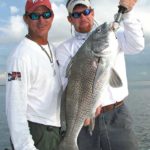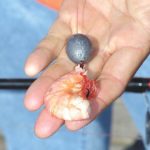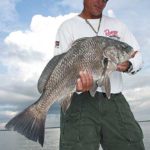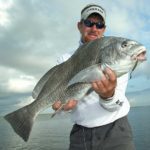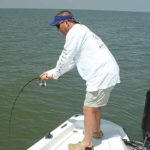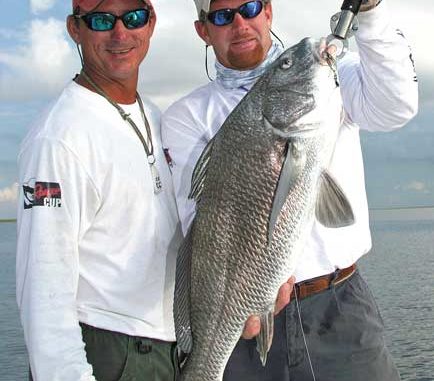
Black drum fall short in looks, but they bring plenty of game and tasty fillets.
They are the unsung heroes, those by whom much responsibility is borne but to whom little credit is ever given. Understudies, back-ups, stunt doubles — these are the one trained to stand in for premier performers when illness, injury or contract clauses prohibit the big names from doing their jobs.
As sport fish go, the red drum earns top billing in South Louisiana waters. A stubborn fight with respectable runs and lots of arm-stretching power make earning those tasty fillets a satisfying chore.
So the reds have game — no one’s questioning that. However, even this top-tier fish has the occasional bad hair day, and the normally cooperative copper warrior can decide to take a timeout.
Frustrating, yes, but take heart in knowing that all is not lost just because a redfish loses interest. There’s usually another member of the drum family ready to step up and take over the rod-bending duties.
Enter Pogonias cromis — the black drum. Hold this fish adjacent to its crimson cousin, and you’ll notice strong resemblances in mouth design and general fin structure.
Differences are also clear. The black drum’s dingy gray tone contrasts the redfish’s shiny amber sides and dark spotted tail. Black drum have taller, huskier profiles than the streamlined redfish. Their pectoral fins are longer, as well.
Perpetually overshadowed by their more popular relative, black drum have long suffered an identity crisis worsened by an inherent lack of respect from anglers who generally overlook what is actually a strong fighting spirit. Truth be told, the burly black drum brings to the table all of the ingredients for a respectable quarry — abundance, appetite and ability (as in fighting).
No doubt, once an angler engages a good-sized drum and feels how much power the stocky body and broom-like tail can generate, the smug indifference melts and a newfound appreciation for a spirited opponent arises.
Few recreational anglers would admit to targeting black drum, but redfish efforts often yield these homely creatures as a surprisingly valuable bycatch. Though not much to look at, especially when compared to the penny-scaled redfish, black drum will turn chance encounters into pleasant angling memories.
And don’t discount the food value. On the dinner table, small to mid-sized drum offer mild white fillets that fry up nicely. Big drum tend to be pretty wormy, so limit your “eaters” to about 10 pounds.
Drum of various sizes abound throughout Louisiana’s coastal waters. Like their red relatives, drum spend their juvenile years inside the marsh habitat and move to outer areas when they reach their adult years.
Mistaken identity
Notwithstanding all that B-team stuff, black drum aren’t shy about stepping up to the plate. Last summer, I joined a couple of redfish anglers who were scouting for an upcoming tournament out of Venice. With plans of snooping around the Delocroix marsh, we launched at Delta Marina in Empire, locked into the river and took a local cut into Quarantine Bay. Our ultimate objective was redfish, but a bent rod is a bent rod.
We were heading north when Danny Adams eased the throttle back and gave his partner and fellow Texan Scott Isbell a nudge.
With scattered storms dancing around our perimeter, building clouds occasionally left gaps through which a glaring morning sun blasted the surface with gilded floodlights. One such illumination had revealed a patch of distinctly nervous water.
“There they are,” Adams said. “That might be redfish, but it could be jacks.”
Off the main channel, the water was about 4 feet deep, so the anonymous school easily slipped on and off our visual radar. Adams stomped the bow to see if he could “bump” up the school, and sure enough, they moved just enough to mark a target. Isbell cast a Berkley Gulp! Shrimp on a 3/8-ounce jighead, while Adams launched a ½-ounce weedless gold spoon.
Isbell struck first.
“I don’t know what they are, but I’ve got one,” Isbell said, as he strained against a fish unlikely to fit the tournament slot.
A doggedly bottom-hugging stubbornness resembled that of a redfish, but it turned out to be a black drum of 15 pounds. Adams noted that drum often run with redfish, so the anglers decided to keep looking. If they could get back on the herd, they’d give any reds a second shot.
Five minutes later, that shot materialized, and when Adams stuck a big fish with his spoon, our collective assumption was “redfish.” However another big drum surfaced with the shiny metal stuck cleanly in its jaw. No snagging, this fish ate the spoon.
“I’ve been to an all-girl rodeo, I’ve been in a parade in Isla Mujeres, Mexico, but I have never seen anything like this — a black drum on a gold spoon!” Adams said.
Here’s a snapshot look at some of the other places to find black drum in South Louisiana.
Rocky relationship
Seeking redfish at the Southwest Pass jetties, former Venice Marina owner Dave Ballay advised his group to target the breaks in structure. Water spilling through the jetties creates a feeding opportunity for redfish and anyone with a similar taste for crustaceans.
As Ballay explained, probing the rocks with a shrimp or a chunk of mullet or pogie on a jighead can be productive, as long as you keep the bait moving. Years of storms, daily tides and angler mishaps have left an eclectic assortment of fishing line, nets, lures and anchor ropes to complement nature’s collection of logs and branches.
Carolina rigs worked well for presenting natural baits over jetty rocks, as the 4-ounce slip sinkers “walked” over the rocks with the current keeping the bait high above the snags.
As we fished, Ballay explained the setup.
“The redfish just run up and down these rocks looking for crabs and shrimp,” he said. “You’ll also catch the black drum mixed in with them.”
True to his word, Ballay unhooked several redfish, along with about half a dozen of the darker drum.
Catch my drift
Rock and oyster reefs in Sabine Lake offered good redfish potential for a tactic known as “dredging.” Basically, we set up a drift across the structures in about 4 to 6 feet and tightlined jigs and swimbaits. Deploying a sea anchor kept our drift at the right pace while holding the boat broadside to the structure so we could drag multiple lines without tangling.
Subsequent passes over the same general area yielded a mix of red and black drum — a clear indication of communal behavior. Reds were all slot size, and the black drum went about 7 pounds on the top end. At that size, we handled the drum well on medium-action spinning tackle, but I was amazed at how aggressively these spry little fellows nailed the baits and then stepped on the gas.
Passing time
Some of the biggest black drum I’ve seen in Louisiana waters came from a most inconspicuous setting — the fuel docks of Belle Pass Marina at Port Fourchon. It was a blustery February morning, and rough weather had blown out all the yellowfin tuna trips.
Left with nothing to do, the would-be clients of a local charter boat stood dejected and bored on the docks. Hoping against hope that the wind would lay, the anglers tarried and talked until someone decided to sling a fresh shrimp toward the channel.
Needless to say, when an estimated 30-pound drum nearly snatched a heavy spinning rod from the hands of a pretty big dude, his buddies quickly joined in the fun. I watched these guys catch and release a trio of 20-plus-pound drum, and they were still going strong when I left. Snapping the heads off of shrimp, they threaded the crustaceans on circle hooks rigged knocker style. (Slip sinker on leader slides, or “knocks,” against the hook.).
Marinas, especially those with lots of traffic and/or current to keep the bottom creatures stirred up, are often-overlooked gold mines for big drum. Scraps from the cleaning tables, unused bait shrimp and other organic discards attract the crabs, and that’s something drum of all sizes cannot resist.
Schools of drum will usually run the channel edges so they can move onto shallow edges to leverage feeding opportunities, without straying too far from the comfort and safety of deep water.
When seeking black drum opportunities, look for concentrations of forage — jetty rocks, oyster reefs, scattered shell bottom and nearshore drilling rigs will all hold lots of tasty critters that drum like to eat.
Bait schools are another good sign. Black drum just aren’t going to chase pogies or finger mullet as fast or as far as the more streamlined redfish, but let a pod of baitfish back themselves into a little pocket or leave themselves vulnerable on a shallow flat, and any drum in the area will locate this feeding opportunity in short order.
Also, pay attention to the liquid dynamics. Moving water carries food sources, and lazy drum make a pretty good living off this delivery service. Falling tides are particularly good for drum fishing, as the outgoing water emerges from inner marsh sanctums much cleaner than it enters. This nutrient-rich flow carries a crustacean and baitfish bounty, so expect eager predators to gather at the run-outs.
Drum-friendly scenarios are many, but realistically, black drum aren’t likely to overtake redfish in popularity. What they will do is provide a worthy backup plan with which to fill the down time between engagements with their ruby relatives.
